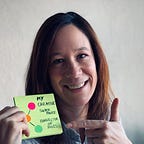Design Thinking is Change Management 2.0
Between 70–84 percent of transformations fail. Why? Reasons include a lack of engagement within the organization and insufficient investment in building capabilities across the organization to sustain the change.
Many organizations still follow the old paradigm of change management a la “I manage. You change.” Some of the models that we still refer to in change management stem from the 1970s. And there is a lot written about the concept of change resistance, but it reinforces this old paradigm of change done to someone else. As grown adults, we don’t like to be told what to do. Do we?
A New Paradigm
It’s time for a more human-centric change approach. That’s why I believe design thinking is change management 2.0. It’s no coincidence that one of the most quoted design thinking books is Tim Brown’s Change by Design.
What if we applied service design principles and methods to the change processes and brought people along on the journey as change co-creators?
Change designers like Lena Ross and Jason Little have documented how they are applying these new change methods inside organizations.
Human-Centric Change Methods
How might we use design thinking methods to drive our change efforts? Here are a few to get your wheels turning:
Identify key stakeholders: One of my favorite design thinking methods is the stakeholder map. It visually depicts everyone who is impact by or affects the change effort. I use this method at the kick off of every project I lead.
Immerse yourself in empathy: Analyze how employees might feel about what’s ahead using empathy interviews and mapping. This should translate into how and what information is communicated to various employee personas during a change effort. Studies on organizational change show that if you want to lead a successful transformation, communicating empathetically is critical.
Use storytelling: Many of us probably experience change as expressed in this delightful analogy courtesy of comedian Amy Poehler: “I guess this is every moment of life. You start the story, and you go: I don’t like this. I don’t get this. Who are these characters? What is this story about? And then in the middle, you’re like: This is so good. I don’t want it to end. Then it ends, and you think the next story is not going to be as good.”
How are you engaging people in the story of your change effort?
Seek ideas from employees: Instead of having authority rest on a few people at the top, ideas and solutions that might drive the change effort can come from the bottom, middle, or anywhere else in the organization. Instead of telling people what to do, ask: “How can we get there?”
Leverage motivational science: We need to get better at understanding behavioral and motivational science and translating it to our work, including to change efforts. Once you understand the elements behind what motivates people, you can then apply learnings to transformational efforts.
Highlight experimentation: One of the greatest organizational transformations many organizations are currently undergoing is the shift to a hybrid work model. This kind of culture shift benefits from small experiments and wins that show real results and encourage people to adopt new norms.
Note: This article was originally published as part of the Design Thinking for HR LinkedIn Newsletter.
ABOUT THE AUTHOR
Design Thinking for HR is a biweekly LinkedIn newsletter that aims to inspire HR professionals to experiment with the human-centered design framework. The newsletter is curated by Nicole Dessain who is an employee experience consultant, design thinking workshop facilitator, and Northwestern University instructor. Nicole is currently writing her first book about Design Thinking for HR. Join the Early Readers’ Community here.
